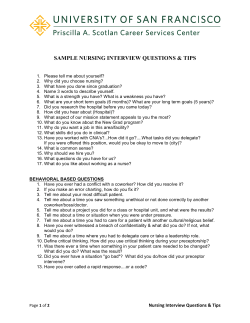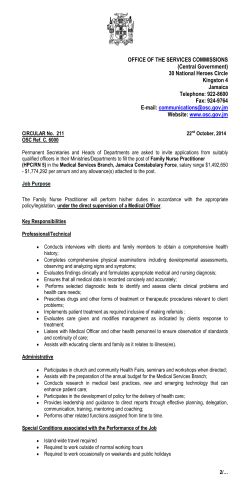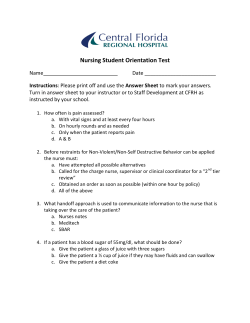
Standards of Professional Performance Introduction Standards of
Standards of Professional Performance 1 2 3 4 5 Introduction Standards of professional performance describe a competent level of behavior in the 6 professional role, including activities related to ethics, education, evidence-based practice and research, 7 quality of practice, communication, leadership, collaboration, professional practice evaluation, resource 8 utilization, and environmental health, The competency statements describe how the standards are met 9 and are not ordered in particular level of importance. 10 11 12 13 14 15 16 17 18 19 20 21 22 23 24 25 26 27 28 29 30 31 32 33 34 35 36 37 38 39 40 41 42 Standard I: Quality of Practice The nurse caring for the acutely and critically ill patient contributes to quality and effectiveness of nursing practice. Competencies: Participates in clinical inquiry through quality improvement activities. Consults to initiate changes in nursing practice and the healthcare delivery system. Ensures that quality improvement activities incorporate appropriate patient and family beliefs, values and preferences. Evaluates practice in an ongoing process, based on best evidence. Identifies barriers to quality care and patient outcomes.. Participates in the development, implementation, evaluation and revision of policies, procedures, and/or guidelines to improve the quality and effectiveness of nursing practice.. Uses creativity and innovation to enhance quality nursing care. Demonstrates quality by documenting the application of the nursing process in a responsible, accountable and ethical manner and a clear and retrievable format. Standard II: Professional Practice Evaluation The nurse caring for the acutely and critically ill patient evaluates his/her own nursing practice in relation to professional practice standards, organizational guidelines, relevant statutes, rules, and regulations. 43 44 45 46 47 48 49 50 51 52 53 54 55 56 57 58 59 60 61 62 63 64 65 66 67 68 69 70 71 72 73 74 75 76 77 78 79 80 81 82 83 84 85 86 87 88 89 Competencies: Engages in a self-evaluation of practice on a regular basis, identifying areas of strength as well as areas where professional growth would be beneficial. Takes action to achieve goals identified in the evaluation process. Obtains feedback regarding his/her own practice from patients, families, peers and professional colleagues. Provides peers with formal or informal constructive feedback regarding their practice or role performance. Standard III: Education The nurse acquires and maintains current knowledge and competence in the care of acutely and critically ill patients. Competencies: Participates in on-going learning experiences and activities to develop and maintain clinical and professional skills and knowledge. Seeks learning opportunities that reflect current and evidence-based practice. Shares educational findings, experiences and ideas with peers. Contributes to a work environment conducive to the education of healthcare professionals. Maintains a professional records or portfolio that provides evidence of competence and life-long learning. Standard IV: Communication The nurse caring for the acutely and critically ill patient uses skilled communication in a variety of formats. Competencies: Assesses communication format preferences of acute and critically ill patients and the interprofessional team. Assesses personal communication skills. .Solicits feedback to continuously improve her or his own communication and conflict resolution skills. 90 91 92 93 94 95 96 97 98 99 100 101 102 103 104 105 106 107 108 109 110 111 112 113 114 115 116 117 118 119 120 121 122 123 124 125 126 127 128 129 130 131 132 133 134 135 136 Conveys accurate information to acutely and critically ill patients and the interprofessional team Questions the rationale supporting care processes and decisions with all members of the interprofessional team. Discloses observations or concerns related to safety, hazards, and errors in care or the practice environment to the appropriate level. Maintains communication with other providers to minimize risks associated with patient handoffs, transfers and transitions in care. Contributes her or his own professional perspective in discussions with the interprofessional team. Standard V: Ethics The nurse’s decisions and actions are carried out in an ethical manner in all areas of practice. Competencies: Practice is guided by the ANA Code of Ethics for Nurses with Interpretive Statements,1 the AACN Core Values and ethical principles. Promotes ethical accountability and integrity in relationships, organizational decisions and stewardship of resources. Protects patient confidentiality within legal and regulatory parameters. Advocates for the concerns of patients, their families and the community. Delivers care in a nonjudgmental and nondiscriminatory manner that meets the diverse needs, of the patient Maintains patient autonomy, dignity, values, beliefs and rights at all times Uses available resources in formulating ethical decisions. Demonstrates a commitment to self-care and self-advocacy. Reports unethical, illegal, incompetent, or impaired practices. Assists patient and family in self-determination and informed decision making Maintains a therapeutic and professional nurse/patient relationship within appropriate role boundaries. 137 138 139 140 141 142 143 144 145 146 147 148 149 150 151 152 153 154 155 156 157 158 159 160 161 162 163 164 165 166 167 168 169 170 171 172 173 174 175 176 177 178 179 180 181 182 Contributes to resolving ethical issues involving the patient, family and interprofessional team. ‘Questions healthcare practice when necessary for safety and quality improvement. Collaborates with the interprofessional team to promote palliative or end-of-life discussions and care. Standard VI: Collaboration The nurse caring for the acutely and critically ill patient collaborates with the patient, family and interprofessional team. Competencies: Partners with others to effect change and produce positive outcomes through knowledge sharing Adheres to standards that govern behavior among the interprofessional team to create a healthy work environment that promotes cooperation, respect and trust. Collaborates with the patient, family and interprofessional team to promote effective and safe transition across care settings Engages in teamwork and conflict resolution. Contributes to creating a interprofessional plan of care. Standard VII: Evidence-based Practice/Research/Clinical Inquiry3 The nurse caring for the acute and critically ill patient uses clinical inquiry and integrates best evidence into practice. Competencies: Questions clinical practices for the purpose of improving the quality of care Describes clinical problems using evidence generated within a clinical setting, such as patient assessment data, outcomes management, and quality improvement data Formulates clinical questions. Participates in evaluating evidence to determine applicability to practice. Assists with integrating evidence into policy, procedure, and practice. 183 184 185 186 187 188 189 190 191 192 193 194 195 196 197 198 199 200 201 202 203 204 205 206 207 208 209 210 211 212 213 214 215 216 217 218 219 220 221 222 223 224 225 226 227 228 229 Implements practice changes based on evidence, clinical expertise, and patient preferences to improve care processes and patient outcomes. Evaluates outcomes of evidence-based decisions and practice changes for individuals, groups, and populations to determine best practices. Disseminates best practices supported by evidence to improve quality of care and patient outcomes. Participates in activities and strategies to sustain an evidence-based practice culture. Standard VIII: Resource Utilization The nurse caring for the acute and critically ill patient uses appropriate resources to plan and provide services that are safe, effective and financially responsible. Competencies: Assesses the individual patient needs and available resources to achieve desired outcomes. Delegates elements of care (as defined by regulatory agencies) to the appropriate individual based upon assessed needs and condition of the patient, potential for harm, patient stability, predictability of the outcomes, competence of the individual, and resources available. Assists the patient and family in identifying and securing appropriate services to address healthrelated needs according to resource availability. Informs the patient and family regarding the options, alternatives, risks, benefits, for nursing interventions. Advocates for additional resources that enhance nursing practice and quality of care. Standard IX: Leadership The nurse caring for the acutely and critically ill patient provides leadership in the professional practice setting as well as the profession. Competencies: Contributes to the creation and maintenance of healthy work environments Supports peers and colleagues through mentoring and other strategies. Demonstrates flexibility and the ability to remain patient-focused in a rapidly changing environment. 230 231 232 233 234 235 236 237 238 239 240 241 242 243 244 245 246 247 248 249 250 251 252 253 254 255 256 257 258 259 260 261 262 263 264 265 266 267 268 269 270 271 272 273 274 275 Directs the coordination of care among caregivers, including oversight of licensed and unlicensed personnel in any assigned or delegated tasks. Participates on committees, councils, and interprofessional teams. Promotes advancement of the profession through participation in professional organizations. Develops a culture of safety for patients, families, and interprofessional team.. Promotes communication of information and advancement of the profession through writing, publishing, and presentations for professional or lay audiences. Promotes development and implementation of innovative solutions. Standard X: Environmental Health The nurse caring for the acutely and critically ill patient maintains a safe and healthy environment. Competencies: Minimizes environmental risk factors that may cause physical harm or injury to patients, families, and the interprofessional team. Implements strategies to reduce the impact of environmental factors that jeopardize health, such as sound, odor, noise, and light. Communicates environmental health risks and exposure reduction strategies to patients, families and colleagues. Uses reliable resources to determine if a product or treatment is an environmental threat. Participates in strategies and activities to promote healthy communities. 1 American Nurses Association. Code of Ethics for Nurses with Interpretive Statements. Washington, DC: American Nurses Association; 2001. 2 American Association of Critical Care Nurses. AACN Core Values. http://www.aacn.org/wd/aacninfo/content/mission-vision-values-ethics.pcms?menu=aboutus. Accessed October 10, 2014. 3 Melnyk, B. M., Gallagher-Ford, L., Long, L. E., & Fineout-Overholt, E. (2014). The establishment of evidence-based practice competencies for practicing registered nurses and advanced practice nurses in real-world clinical settings: proficiencies to improve healthcare quality, reliability, patient outcomes, and costs. Worldviews on Evidence-Based Nursing, 11(1), 5-15.
© Copyright 2025















